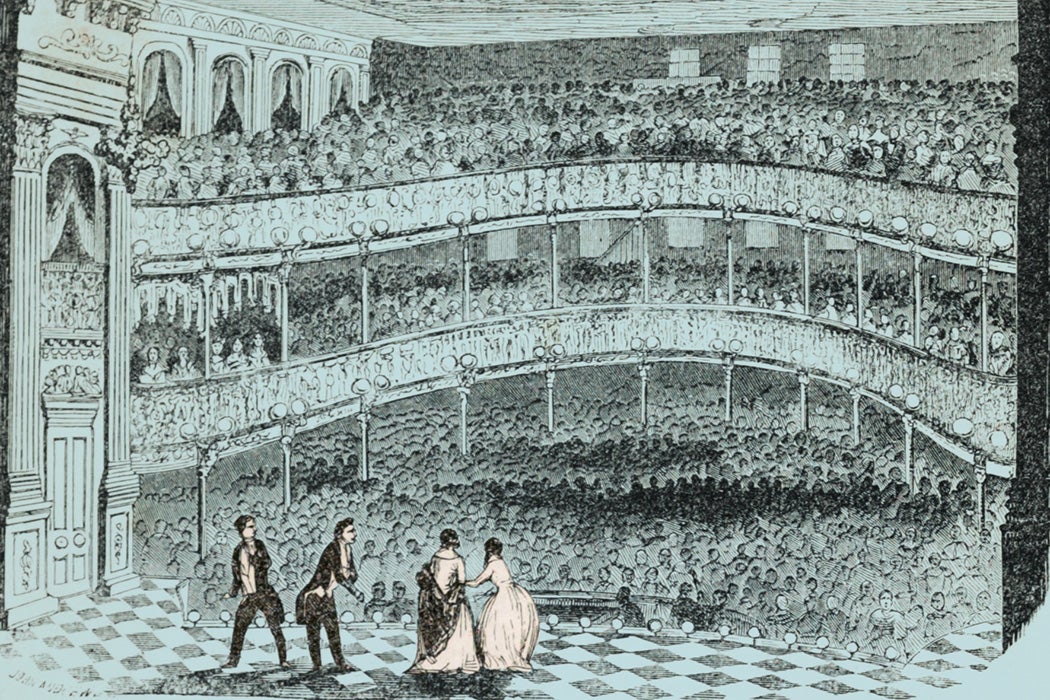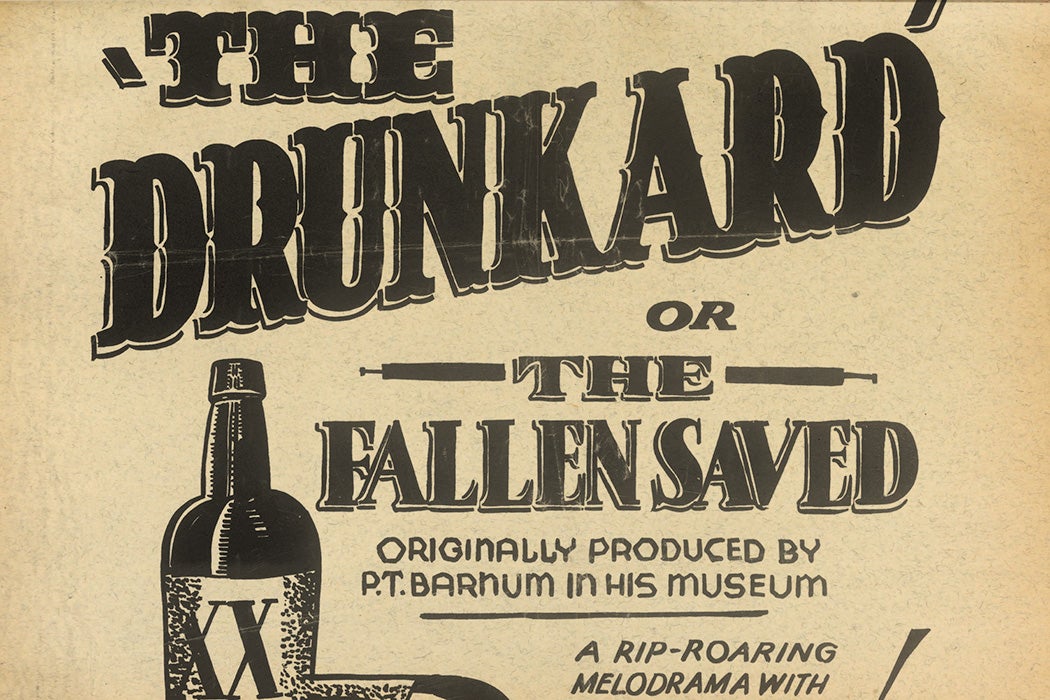The longest-running Broadway shows count thousands of performances—in the case of the undisputed champ, Andrew Lloyd Webber’s The Phantom of the Opera, more than ten thousand. But theater records had to start somewhere, and the first show to run for a hundred performances in New York City was a melodrama warning theatergoers about the dangers of alcohol.
P. T. Barnum had promised to offer “highly moral and instructive domestic dramas” in the newly renovated theater of his American Museum, which seated three thousand in a hall decorated with crimson damask wallpaper, patriotic portraits, and a giant proscenium arch bearing the motto “We Study to Please.” Thousands cozied into Barnum’s velvet seats in 1850 when he made good on the promise by presenting The Drunkard, or, The Fallen Saved, and it wasn’t just Barnum’s own personal commitment to sobriety that drove its marquee status and its record-setting run.
In the mid-nineteenth century, it wasn’t difficult to encounter the temperance movement. This was certainly a shift from early America, in which tavern culture was fundamental and each American typically drank gallons per capita, for a variety of reasons ranging from public health to nutrition to fun. But the decades leading up to the Civil War marked young America’s greatest period of urban expansion to date—Michael D’Alessandro notes that between 1820–1860, urban populations grew 797 percent. As cities grew, a broad coalition of social and religious interests decided to reductively blame booze rather than systemic social problems for poverty and other social ills among immigrant populations and the working class. In The Dangerous Classes of New York, Charles Loring Brace argued that the temperance movement “has addressed the working-man—as, in fact, he often is—as a child, and saved him from his own habits, by a sworn abstinence.”
Temperance took hold. The 1851 “Maine Law,” a proto-Prohibition by which Maine generally prohibited the sale of alcohol, kicked off a chain of similar legislation in other states. Various temperance societies formed, holding meetings and asking members to sign an abstinence pledge (like those in the UK) or carry token medals. Temperance songs were even included in children’s school songbooks of the era.
It’s little surprise that temperance advocates used mass entertainment to reinforce their messaging, too. Throughout the nineteenth century, hundreds of temperance dramas, ranging as Judith McArthur says, from “verbose wooden sketches for amateur players to elaborate five-act melodramas,” were written to provide audiences with some safe thrills and a sense of their own better morality. (Most of the scripts, McArthur notes, “were forgettable.”)
The plays shared a common structure, an “inverted arc” in which a young, working, family man is tempted to drink, then “slides into complete moral and financial degradation before renouncing alcohol and fulfilling his destiny as he rises on the ladder of economic success and social prestige.” While written in broad-brush schlock, the plays were nonetheless very popular. Hot Corn, for example, told the story of a poor child selling roasted corn on the city streets to support her drunken family—beginning life as an alleged exposé, the written pamphlet sold 50,000 copies in six months and was promptly adapted for the stage.

Since theater had a mixed reputation in early America, promoters like Moses Kimball in Boston and Barnum in New York used their popular museums to provide a safe, family-friendly entertainment environment to court middle-class patrons and their disposable income. In many cases, this meant showcasing moral subject matter, with the logic that it was both edifying and educational, and therefore respectable (Barnum showed not only temperance drama but a bowdlerized version of Uncle Tom’s Cabin). A melodramatic play to let middle-class patrons and tourists experience city toughs and tawdry slums while scaring them straight was just the thing.
The Drunkard was largely written by William H. Smith, who first staged it in 1844 at Moses Kimball’s Boston Museum and Gallery of Fine Arts. It went on to be performed in Philadelphia, Cincinnati, and Brooklyn before opening in 1850 at Barnum’s. In the play, young, white-bread Edward Middleton has married Mary Wilson, and the couple is living in domestic idyll. Squire Cribbs, an evil lawyer with the snappy nickname “Razor Chops,” lusts after Mary and, since he has an axe to grind with the Middleton family, he decides to ruin Edward in revenge with a few glasses of brandy.
Instantly torpedoed, the debauched Edward wrecks his life and retreats in shame to New York City, where he’s rescued from urban squalor and the DT’s (always rendered especially dramatically by the actor, hollering about snakes and wanting to “poison it with rum”) by an inexplicably sunny and wealthy do-gooder named Arden Rencelaw. Restored to health and harmony, Middleton returns home while the neighbors sing temperance hymns as if it’s an episode of Glee.
The play was formulaic by design, showing temptation, ruin, and redemption in a neat five-act package. It pitted nobility against depravity, the big bad city and its Pleasure Island-abandon against naïve tourists and generally nice people. Promoters such as Barnum and Kimball would make sure the scenery and maybe a few local references tied the play neatly to their home venue. Folks could grab a copy of the pledge on their way out the door if they liked.
Weekly Newsletter
No one much seemed to mind the contradictions inherent in these plays. Temperance melodrama drew a line between its protagonist victims and the villain predators who went after them, generally blaming the purveyors of alcohol—deceivers, liquor-sellers, even the fact of temptation itself—rather than the drinker. At the same time, it was the main character’s act of free will that doomed him and then later turned the tables to sobriety and redemption. “Not a single example of temperance literature,” writes Jeffrey Mason, “suggests fundamental social change as a solution to the problem; every temperance narrative assumes that some form of individual action is necessary.”
The plays had their flaws, but then again, maybe the temperance folks knew popular audiences better than we all think. The Drunkard continued in popularity even after the heyday of the temperance movement, running in productions during the Federal Theatre Project era, enjoying a decades-long run in Los Angeles that attracted the likes of Boris Karloff and Mary Pickford, and inspiring a 1970s Barry Manilow musical version.
Support JSTOR Daily! Join our new membership program on Patreon today.







